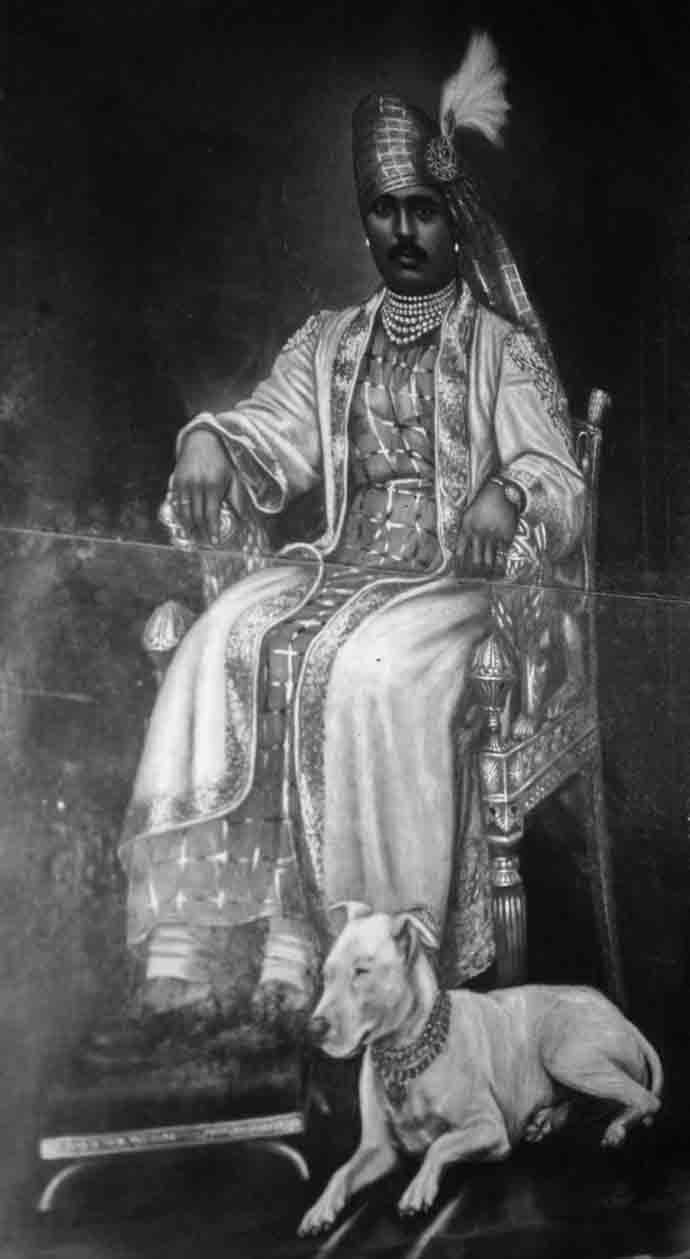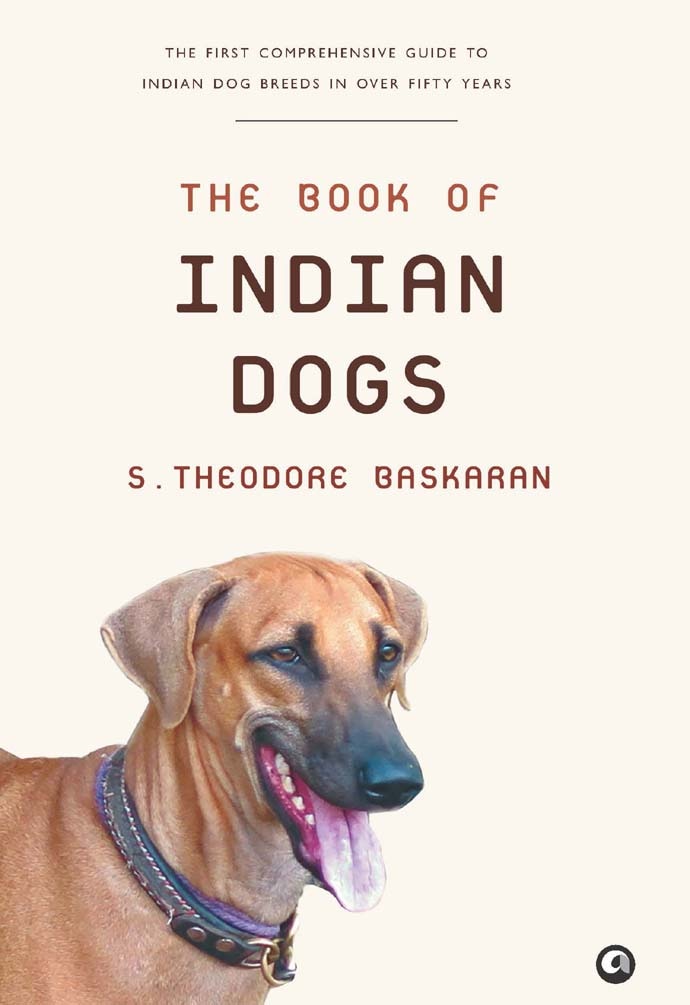A brief history of Indian dogs

As the Raj extended its shadow over India, the number of Indian rajas importing foreign breeds increased. A good example of this was the Nawab of Junagadh, Mohbet Khan Rasul Khan, who owned 150 dogs including bull terriers and Border collies with a separate kennel and caretaker for each dog.
There was a veterinarian, an Englishman, to take care of them.
When the nawab wanted to see any one of the dogs, it was brought to him in a palanquin. The nawab was fond of hunting and he owned a pack of hounds, which he used for that purpose. Oil portraits of his favourite dogs, that he commissioned British painters to paint, are still exhibited in Junagadh Palace.
They wore diamond-studded collars. One painting shows a marriage between two of his dogs, the celebrations of which lasted for three days (including one day which was declared a state holiday).
 |
| Nawab of Junagad with his dog. |
The nawab invited Lord Irwin to one such event, but the Governor General politely declined the invitation. It is recorded that a number of the nawab's vassals attended the wedding in full ceremonial dress.
After the Partition of India in 1947, as he was fleeing to Pakistan on a Dakota plane which was filled with his wives, treasure and dogs, one of his four wives on board found that her child had been left behind. She asked the nawab to wait and rushed to the palace to get the child. He filled the vacant seat with two dogs and fled.
Once the wave of imported dog breeds arrived in India, crossbreeding was inevitable.
Since many of the imported dogs could not stand the heat of the plains, some dog fanciers began to cross them with local breeds in order to have dogs that were tough and could withstand the heat. The gene pool that had remained almost inviolate for centuries got diluted.
Some British dog fanciers, however, did try and preserve the uniqueness of Indian breeds, particularly that of Himalayan dogs.
Understandably so, because of all Indian dog breeds, dogs in the Himalayas had grown closest to humans, and had been given the run of the house, a privilege the dogs of the plains did not enjoy.
In fact, the sheepdogs, which were mostly in the Himalayas, were much closer to humans than the hunting dogs of the plains, which were kept separately and taken out only on hunting trips. The concept of ritual pollution through dogs was unknown among the people of the hilly region.
 |
| Rajapalayam dog at show in Nagercoil. Photo: S Theodore Baskaran |
There was another reason for the British attraction to Himalayan dogs. With their bushy coats, these dogs resemble certain European breeds. Their thick coats enabled them to withstand the cold. This meant they could tolerate the English weather.
Consequently, some of these breeds were exported to England. They were given English names like Tibetan terrier and Tibetan spaniel. Soon an association of owners of Indian dogs was founded in England with 2,000 members.
In India, the British interest in dogs manifested itself in the form of dog-fancier clubs. In 1896, the North Indian Kennel Association, a precursor to the Kennel Club of India, was formed in Lahore, where it held its first dog show.
In 1900, it was affiliated with the Kennel Club of London, and in 1908 it became the Kennel Club of India with Lord Minto, the viceroy of India, as its president.
 |
| The Bakharwal. |
Reverend Herbert Wheeler Bush, who spent nearly two decades in India, from 1881 onwards, in Delhi and Jullundur (present-day Jalandhar), was one of the first Britons to take a keen interest in Indian dog breeds.
Reverend Bush, while talking about the Banjara breed in The Kennel Encyclopaedia, said: "Eastern sportsmen have never yet, within the memory of Englishmen, set themselves to consistently manufacture a breed for special purpose."
Oxford-educated Reverend Bush served in India in various places such as Delhi, Dalhousie and Sialkot. For a few years he was the principal of Lawrence School in Murree. In due course, he earned the reputation of being an expert on "Eastern and Oriental hounds".
The notes he left about some of them, including one on the Afghan hound he raised, gives us an idea of the scene at the time. He was a key figure in founding the Kennel Club of India and in drawing attention to Indian breeds. He founded the Kennel Gazette, which is still published every month with impressive regularity from Chennai as the Indian Kennel Gazette. He died in Britain in 1927.
Gradually, clubs were founded in metropolitan areas and dog shows were held. Beginning in 1952, shows were held in Ootacamund.
 |
| The Himalayan sheep dog accompanies Ladakh's Changpa. Photo: Nithila Baskaran |
However, no sustained interest was shown in local breeds of dogs until the 1960s. Until then, even prominent Indian leaders were usually only interested in imported breeds.
In photographs Dr BR Ambedkar is seen with a pair of fox terriers.
Down south, EV Ramasamy Naicker's favourite breed was the dachshund. Jawaharlal Nehru had a honey-coloured golden retriever whom he had named Madhu.
***
By one account India has about four million pet dogs which is much less than the eighty-three million in the United States. However, in India, the number of dogs being kept as pets is growing at the rate of 15 per cent a year. Pet clinics and the pet goods trade are also increasing.
Bangalore has seen about fifty dog spas (where owners bring their pet dogs for bathing and grooming) coming up in the last three years.
According to another estimate, there are 1,432,522 96 pet dogs in Bangalore. But very few of them are indigenous dogs.
The concept of breeds, as it is known today, was not common in the subcontinent until recently.
People used a variety of expressions to distinguish between the various kinds of dogs.
 |
| The Book of Indian Dogs; S Theodore Baskaran; Aleph Book Company |
In Tamil, for example, it was common to use the word "caste" (jathi) in place of "breed".
I think that this is true of other languages as well-in the 1990s, when I was taking my dachshund for a walk one morning in Ahmedabad, a curious youngster approached me and asked in English, "Uncle! What caste is your dog?"
This might be amusing but even in countries where breeds have been recognised for much longer it was only in the last two centuries or so that the idea of breeds and breed characteristics took firm root, as a consequence of the formation of associations and clubs devoted to dogs.
In India, some dog enthusiasts argue that Indian breeds are landraces and not breeds.
What is meant by this is that these animals belong to a specific area and are raised by a specific community or tribe. Within the "breed" sizes and colour vary.
In recent decades, we have moved away from such rough and ready methods of classification and an attempt has been made to standardise Indian breeds, especially since the Kennel Club of India began to allow Indian breeds to be shown in the ring and insisted on certain standards being met.
However, as there has been no real attempt to establish a methodical and scientific way to classify and set standards for the various breeds, there is little standardisation of characteristics within breeds.
(Excerpted with permission from Aleph Book Company.)

